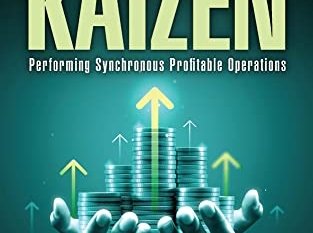In “Beyond Strategic Kaizen: Performing Synchronous Profitable Operations,” Alin Posteucă provides a fresh perspective on the concepts of Kaizen and continuous improvement by integrating them with the principles of synchronous operations. The result is a compelling blend of Eastern and Western management philosophies that promises to reshape how organizations approach productivity, profitability, and employee engagement.
Posted begins by establishing a solid foundation on the principles of Kaizen and continuous improvement, tracing their roots back to Japan after World War II. He demonstrates the cultural and historical context of Kaizen, using the words of Masaaki Imai, the founder of the Kaizen Institute: “Kaizen means improvement. Moreover, it means continuing improvement in personal life, home life, social life, and working life” (Imai, 1986). By doing so, Posteuca effectively sets the stage for a more comprehensive understanding of Kaizen as a holistic process that transcends the mere application of tools and techniques.
The author then delves into the concept of synchronous operations, which originated from the work of Eliyahu M. Goldratt, an Israeli physicist turned management guru. Goldratt’s Theory of Constraints (TOC) is described as a “powerful systems-based approach to managing complex organizations, focused on identifying and managing the critical few constraints that limit the organization’s performance” (Goldratt, 1984). Posteuca argues that combining the principles of Kaizen with TOC can help organizations achieve sustainable growth while maintaining high employee engagement.
A notable strength of “Beyond Strategic Kaizen” is the author’s emphasis on practicality. Posteuca provides several case studies, offering real-world examples of how organizations have successfully integrated Kaizen and synchronous operations. These stories illustrate the benefits of combining these approaches and demonstrate the challenges that may arise. This pragmatic approach is further supported by including actionable steps, tools, and methodologies that managers and practitioners can use to implement these concepts in their organizations.
The book is also peppered with insightful quotes from renowned management thinkers, such as Peter Drucker and W. Edwards Deming, who provide thought-provoking commentary on the importance of continuous improvement and the role of management in fostering a culture of innovation. For instance, Deming’s famous quote, “It is not enough to do your best; you must know what to do, and then do your best” (Deming, 1982), highlights the importance of clear guidance and direction for employees to maximize their potential.
In conclusion, “Beyond Strategic Kaizen: Performing Synchronous Profitable Operations” is valuable to the literature on continuous improvement and operations management. Mihai Posteuca expertly weaves the principles of Kaizen and synchronous operations to offer a refreshing, practical, and actionable approach to organizational excellence. This book is a must-read for managers, executives, and practitioners looking to elevate their organizations to new heights of performance and profitability.
Author: Alin Posteucă
Publisher: Routledge Publication
Date: 2023 ISBN: 9781032330358
References:
- Deming, W. E. (1982). Out of the Crisis. MIT Center for Advanced Engineering Study.
- Goldratt, E. M. (1984). The Goal: A Process of Ongoing Improvement. North River Press.
- Imai, M. (1986). Kaizen: The Key to Japan’s Competitive Success. McGraw-Hill.
















Alin Posteuca not Mihai Posteuca
Hi Alin, thanks for identifying the mistake. It has been corrected. Thanks for the book as well; great resource.